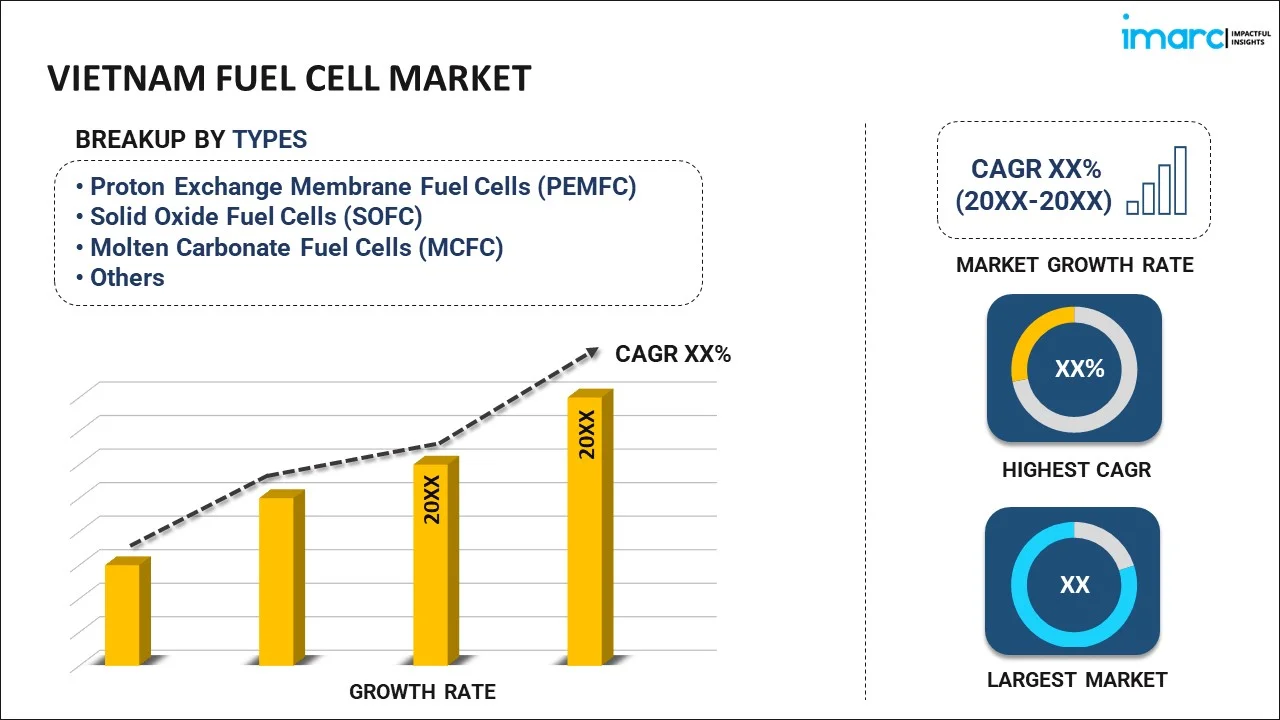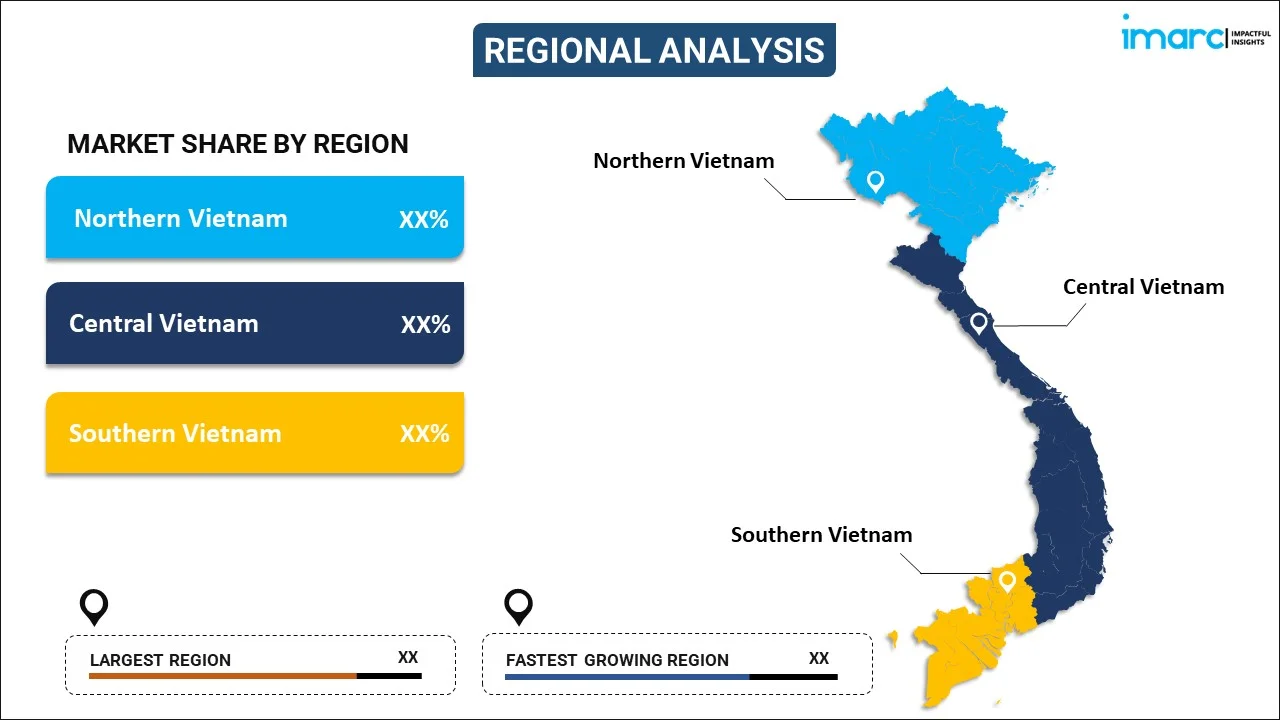
Vietnam Fuel Cell Market Report by Type (Proton Exchange Membrane Fuel Cells (PEMFC), Solid Oxide Fuel Cells (SOFC), Molten Carbonate Fuel Cells (MCFC), Direct Methanol Fuel Cells (DMFC), Phosphoric Acid Fuel Cells (PAFC), and Others), Application (Stationary, Transportation, Portable), and Region 2025-2033
Market Overview:
Vietnam fuel cell market size is projected to exhibit a growth rate (CAGR) of 35.70% during 2025-2033. The global shift towards clean and sustainable energy sources, the increasing research and development efforts, the rapid advancements in fuel cell technology, the growing interest in a hydrogen-based economy, and the escalating desire to reduce dependence on traditional energy sources and enhance energy security are some of the factors propelling the market.
|
Report Attribute
|
Key Statistics
|
|---|---|
|
Base Year
|
2024 |
|
Forecast Years
|
2025-2033
|
|
Historical Years
|
2019-2024
|
| Market Growth Rate (2025-2033) | 35.70% |
A fuel cell is an electrochemical device that converts chemical energy directly into electrical energy through the reaction between a fuel and an oxidizing agent, typically oxygen or air. It operates on the principle of electrochemical reactions occurring at two electrodes, the anode and the cathode, separated by an electrolyte. The most common type of fuel cell utilizes hydrogen as the fuel. At the anode, hydrogen molecules undergo oxidation, splitting into protons (H+) and electrons (e-). The protons then move through the electrolyte to the cathode, while the electrons are forced to follow an external circuit, generating an electric current. At the cathode, the electrons and protons recombine with oxygen from the air, producing water and releasing additional electrical energy. Fuel cells offer several advantages, including high energy efficiency, reduced greenhouse gas emissions, and low environmental impact. Unlike traditional combustion-based power generation, fuel cells do not rely on burning fuel, and their operation produces minimal pollutants. Additionally, fuel cells are characterized by quiet and smooth operation, making them suitable for a variety of applications, from stationary power generation to transportation and portable electronic devices. There are various types of fuel cells, each with specific characteristics and applications. Proton exchange membrane (PEM) fuel cells, for instance, are commonly used in transportation, including fuel cell vehicles, due to their relatively high power density and quick start-up times. Solid oxide fuel cells (SOFCs) find applications in stationary power generation, providing electricity for homes and businesses. Molten carbonate fuel cells (MCFCs) and phosphoric acid fuel cells (PAFCs) are other types used in different contexts. The adoption of fuel cells is particularly significant in the context of the global transition toward clean and sustainable energy. As a versatile and efficient technology, fuel cells contribute to reducing dependence on fossil fuels and mitigating environmental impact. However, challenges remain, including the development of cost-effective and durable materials, infrastructure for hydrogen production and distribution, and broader market acceptance. As research and development efforts continue to address these challenges, fuel cells are poised to play a vital role in the future energy landscape, offering a cleaner and more sustainable alternative to traditional power generation methods.
Vietnam Fuel Cell Market Trends:
The market in Vietnam is majorly driven by the evolving energy landscape and the global transition towards sustainable technologies. In line with this, the increasing emphasis on clean energy sources and the commitment to reducing carbon emissions are creating a positive outlook for the market. As part of global efforts to combat climate change, Vietnam has recognized the importance of adopting environmentally friendly technologies, and fuel cells, known for their low emissions and high energy efficiency, are gaining prominence in the country's energy strategy. Furthermore, government support and initiatives play a crucial role in propelling the fuel cell market in Vietnam. The government has implemented policies and incentives to encourage the adoption of clean energy solutions, including financial incentives, subsidies, and regulatory support. Such measures reduce the initial costs associated with fuel cell installations, making them more attractive to businesses and investors. Vietnam's commitment to promoting renewable energy aligns with the global shift towards sustainable practices and contributes to the growing momentum of the fuel cell market. Additionally, the versatility of fuel cells and their applicability in diverse sectors contribute to market growth. Fuel cells find applications in stationary power generation, transportation, and portable devices, offering a range of solutions to meet different energy needs. In the transportation sector, for example, fuel cell vehicles are gaining attention as a cleaner alternative to traditional internal combustion engine vehicles. This versatility makes fuel cells well-suited to address a variety of energy challenges across various industries in Vietnam. Besides, the country's focus on energy security is another driving factor for the fuel cell market. Fuel cells provide a decentralized and reliable source of power, which is crucial for enhancing energy security and reducing dependence on traditional energy sources. As Vietnam continues to experience economic growth and urbanization, the demand for reliable and sustainable energy solutions is on the rise, further fueling the adoption of fuel cells. Moreover, the partnerships and collaborations between local and international entities contribute to the growth of the fuel cell market in Vietnam. Knowledge transfer, technology exchange, and joint ventures facilitate the integration of fuel cell technologies into the Vietnamese energy infrastructure. These collaborations enhance the local expertise in fuel cell deployment and contribute to the overall development of the clean energy sector, strengthening the market.
Vietnam Fuel Cell Market Segmentation:
IMARC Group provides an analysis of the key trends in each segment of the market, along with forecasts at the country level for 2025-2033. Our report has categorized the market based on type and application.
Type Insights:

- Proton Exchange Membrane Fuel Cells (PEMFC)
- Solid Oxide Fuel Cells (SOFC)
- Molten Carbonate Fuel Cells (MCFC)
- Direct Methanol Fuel Cells (DMFC)
- Phosphoric Acid Fuel Cells (PAFC)
- Others
The report has provided a detailed breakup and analysis of the market based on the type. This includes proton exchange membrane fuel cells (PEMFC), solid oxide fuel cells (SOFC), molten carbonate fuel cells (MCFC), direct methanol fuel cells (DMFC), phosphoric acid fuel cells (PAFC) and others.
Application Insights:
- Stationary
- Transportation
- Portable
A detailed breakup and analysis of the market based on the application have also been provided in the report. This includes stationary, transportation, and portable.
Regional Insights:

- Northern Vietnam
- Central Vietnam
- Southern Vietnam
The report has also provided a comprehensive analysis of all the major regional markets, which include Northern Vietnam, Central Vietnam, and Southern Vietnam.
Competitive Landscape:
The market research report has also provided a comprehensive analysis of the competitive landscape in the market. Competitive analysis such as market structure, key player positioning, top winning strategies, competitive dashboard, and company evaluation quadrant has been covered in the report. Also, detailed profiles of all major companies have been provided.
Vietnam Fuel Cell Market Report Coverage:
| Report Features | Details |
|---|---|
| Base Year of the Analysis | 2024 |
| Historical Period | 2019-2024 |
| Forecast Period | 2025-2033 |
| Units | Billion USD |
| Scope of the Report | Exploration of Historical and Forecast Trends, Industry Catalysts and Challenges, Segment-Wise Historical and Predictive Market Assessment:
|
| Types Covered | Proton Exchange Membrane Fuel Cells (PEMFC), Solid Oxide Fuel Cells (SOFC), Molten Carbonate Fuel Cells (MCFC), Direct Methanol Fuel Cells (DMFC), Phosphoric Acid Fuel Cells (PAFC), Others |
| Applications Covered | Stationary, Transportation, Portable |
| Regions Covered | Northern Vietnam, Central Vietnam, Southern Vietnam |
| Customization Scope | 10% Free Customization |
| Post-Sale Analyst Support | 10-12 Weeks |
| Delivery Format | PDF and Excel through Email (We can also provide the editable version of the report in PPT/Word format on special request) |
Key Questions Answered in This Report:
- How has the Vietnam fuel cell market performed so far and how will it perform in the coming years?
- What has been the impact of COVID-19 on the Vietnam fuel cell market?
- What is the breakup of the Vietnam fuel cell market on the basis of type?
- What is the breakup of the Vietnam fuel cell market on the basis of application?
- What are the various stages in the value chain of the Vietnam fuel cell market?
- What are the key driving factors and challenges in the Vietnam fuel cell?
- What is the structure of the Vietnam fuel cell market and who are the key players?
- What is the degree of competition in the Vietnam fuel cell market?
Key Benefits for Stakeholders:
- IMARC’s industry report offers a comprehensive quantitative analysis of various market segments, historical and current market trends, market forecasts, and dynamics of the Vietnam fuel cell market from 2019-2033.
- The research report provides the latest information on the market drivers, challenges, and opportunities in the Vietnam fuel cell market.
- Porter's five forces analysis assist stakeholders in assessing the impact of new entrants, competitive rivalry, supplier power, buyer power, and the threat of substitution. It helps stakeholders to analyze the level of competition within the Vietnam fuel cell industry and its attractiveness.
- Competitive landscape allows stakeholders to understand their competitive environment and provides an insight into the current positions of key players in the market.
Need more help?
- Speak to our experienced analysts for insights on the current market scenarios.
- Include additional segments and countries to customize the report as per your requirement.
- Gain an unparalleled competitive advantage in your domain by understanding how to utilize the report and positively impacting your operations and revenue.
- For further assistance, please connect with our analysts.
 Request Customization
Request Customization
 Speak to an Analyst
Speak to an Analyst
 Request Brochure
Request Brochure
 Inquire Before Buying
Inquire Before Buying




.webp)




.webp)












